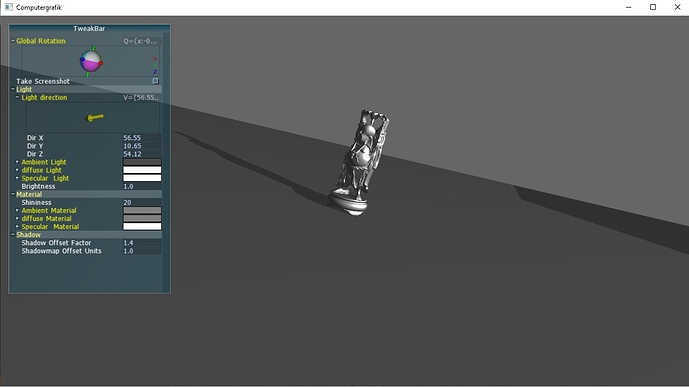Hello everyone,
I am new to this so please be forgiving when I cannot explain my situation in a way where everyone instantly understands the problem but I am already thankful for your help!
I am working with OpenGL so Coding in C++.
Task:
I have a simple scene where I have one object, a one-point source of light, and a camera. Now I am moving the light around the object and up. When I reached all positions I want, I rotate the object and/or move the camera upwards. When I got all the positions of the light and the camera, I switch the object.
Of course, all the time the lighting and the shadows should be correct. But currently, this is not the case. Which leads me to the…
Problem:
Sometimes there are shadows in the background where actually shouldn’t be one
[iamge with the wrong shadow in the back][1]
I expect that the shadow map is not big enough to capture this part of the scene. Because of multiple changes in the scene, I want to automate the definition of the size of the shadow map.
What I have so far:
I define the maximal bounding box around every object to know the maximal dimensions here. Through drawing the bounding box and debugging I can say that this is calculated correctly. (I know that I have to take the extent of the base surface into account as well but to clarify if my algorithm works well, I leaf that out for a second)
To geht the extents on the near clipping plane, I project them onto the near clipping plane of the light source to get dimantions for the shadow map I need to use.For the Projection I span the base for the plane with the up and the right vector of the plane. The projection matrix I calculate with A * (A^T * A)^(-1) * A^T
When I now switch the view so that I see the scene from the perspective of the light, I see what I expect: The whole picture is just the object.
[object from the light perspective][2]
So far so good. But when I move the light the to ritht or the left, parts of the image move out of the field of view.
[light moved to the right][3]
When I move the light up the object gets swaged.
[light moved up][4]
Here is my code to adjust the lightsource_projection:
void CGRenderer::adjustLight()
{
glm::mat2x3 A(9.0f);
A[1] = lightsource_camera.getUp();
A[0] = lightsource_camera.getRight();
//projection matrix = A(ATA)^-1 AT.
glm::mat3 P = A * glm::inverse(glm::transpose(A) * A) * glm::transpose(A);
std::vector<glm::vec3> bbPoints;
bbPoints.push_back(glm::vec3(object.boundingBoxViewSpace[0][0], object.boundingBoxViewSpace[0][1], object.boundingBoxViewSpace[0][2]));
bbPoints.push_back(glm::vec3(object.boundingBoxViewSpace[1][0], object.boundingBoxViewSpace[0][1], object.boundingBoxViewSpace[0][2]));
bbPoints.push_back(glm::vec3(object.boundingBoxViewSpace[0][0], object.boundingBoxViewSpace[0][1], object.boundingBoxViewSpace[1][2]));
bbPoints.push_back(glm::vec3(object.boundingBoxViewSpace[1][0], object.boundingBoxViewSpace[0][1], object.boundingBoxViewSpace[1][2]));
bbPoints.push_back(glm::vec3(object.boundingBoxViewSpace[0][0], object.boundingBoxViewSpace[1][1], object.boundingBoxViewSpace[0][2]));
bbPoints.push_back(glm::vec3(object.boundingBoxViewSpace[1][0], object.boundingBoxViewSpace[1][1], object.boundingBoxViewSpace[0][2]));
bbPoints.push_back(glm::vec3(object.boundingBoxViewSpace[0][0], object.boundingBoxViewSpace[1][1], object.boundingBoxViewSpace[1][2]));
bbPoints.push_back(glm::vec3(object.boundingBoxViewSpace[1][0], object.boundingBoxViewSpace[1][1], object.boundingBoxViewSpace[1][2]));
glm::vec3 tmp;
float x_min = 0.f;
float x_max = 0.f;
float y_min = 0.f;
float y_max = 0.f;
for (glm::vec3 v : bbPoints)
{
tmp = v * P;
if (tmp.x < x_min)
x_min = tmp.x;
if (tmp.x > x_max)
x_max = tmp.x;
if (tmp.y < y_min)
y_min = tmp.y;
if (tmp.y > y_max)
y_max = tmp.y;
}
parameter.lightprojection_x_min = x_min;
parameter.lightprojection_x_max = x_max;
parameter.lightprojection_y_min = y_min;
parameter.lightprojection_y_max = y_max;
lightsource_projection = glm::ortho(parameter.lightprojection_x_min, parameter.lightprojection_x_max,
parameter.lightprojection_y_min, parameter.lightprojection_y_max,
parameter.lightprojection_z_min, parameter.lightprojection_z_max);
}
Here my shadow pass function where I adjust the light and use the newly calculated lightsource_projection:
void CGRenderer::shadowmap_pass()
{
glBindFramebuffer(GL_FRAMEBUFFER, framebuffers.shadowmap_buffer);
glViewport(0, 0, shadowmap_width, shadowmap_height);
glClear(GL_DEPTH_BUFFER_BIT | GL_COLOR_BUFFER_BIT);
model = glm::scale(glm::mat4_cast(parameter.globalRotation), glm::vec3(parameter.modelScalation));
model = glm::rotate(glm::mat4(1.f), glm::radians(parameter.modelRotation), glm::vec3(0.f, 1.f, 0.f)) * model;
glm::mat4 shadow_view = lightsource_camera.getViewMatrix();
glm::mat4 shadow_model_view = shadow_view * model;
adjustLight();
shader->use();
glUniformMatrix4fv(locs.modelViewProjection, 1, GL_FALSE, glm::value_ptr(lightsource_projection * shadow_model_view));
glUniformSubroutinesuiv(GL_VERTEX_SHADER, 1, &locs.placementVS);
glUniformSubroutinesuiv(GL_FRAGMENT_SHADER, 1, &locs.depthmapFS);
glBindVertexArray(basesurface.vao);
glDrawArrays(GL_TRIANGLES, 0, basesurface.vertsToDraw);
glBindVertexArray(object.vao);
glDrawArrays(GL_TRIANGLES, 0, object.vertsToDraw);
}
Questions:
Why is it not updating the projection correctly? How can I fix that problem? Do I need to change the view matrix to solve the problem?
Any ideas the solve the problem are welcome. If you know different algorithms that do the work, I am happy with that, too.
Kind regards and many thanks!
